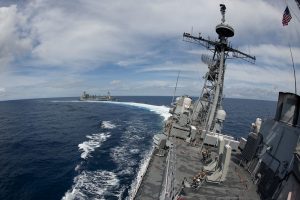The South China Sea Arbitration case decided on July 12, 2016 was an arbitration case brought against China for its effective control of maritime features in the South China Sea that are part of a territorial dispute. The case was decided in favor of the plaintiff, the Philippines, with the arbitral tribunal rejecting China’s claim of the “Nine-Dash Line,” in which China claimed historical rights over most of the South China Sea.
On the day the ruling was released, China’s Ministry of Foreign Affairs declared that “Its [the arbitration’s] existence is illegal, and whatever ruling it makes is null and void, with no binding force.” In reality, China has succeeded in turning seven artificial islands built from reefs and other features into military bases. After a U.S.-China summit in September 2015, Chinese President Xi Jinping stated that “China does not intend to pursue militarization in the South China Sea,” but in fact China has done just that. In February 2016, the Chinese Foreign Ministry explained that “China’s deployment of limited defense facilities on its own territory (the Spratly Islands) is its exercise of self-defense right to which a sovereign state is entitled under international law. It has nothing to do with militarization.” What is clear from these facts is that China is neglecting its obligation to respect the binding arbitration award. China continues its activities that go against international law.
In November 2002, China agreed with ASEAN countries to the “Declaration on the Conduct of Parties in the South China Sea (DOC).” The declaration promises, among other things, the observance of the Charter of the United Nations, the United Nations Convention on the Law of the Sea (UNCLOS), the Treaty of Amity and Cooperation in Southeast Asia (TAC), and the resolution of territorial disputes by peaceful means. It also establishes restraint of actions that could cause conflicts to intensify. However, China has ignored this political accord and has advanced its territorial fait accompli in the South China Sea.
After the arbitration, the chairman’s statement was announced at a summit between China and ASEAN countries held in Lao on September 7, 2016. In this statement, a goal was set to conclude talks in the first half of 2017 regarding the legally binding “Code of Conduct in the South China Sea (COC),” which is linked to the South China Sea issue. As of 2021, this goal has still not been achieved. The focus must be on China’s actions to exclude countries outside the region from decisions regarding the COC. China is stepping up pressure to prevent littoral nations from participating in military exercises or seabed resource development with countries outside the region. ASEAN countries are negotiating with China, which is refusing to respect the legally binding South China Sea Arbitration award, hoping that it will honor new legally binding agreements. As such, it is premature to consider that the “rule of law has been established in the South China Sea through the signing of the “Code of Conduct.”
Under the China Coast Guard Law (CCG Law), which was enacted on February 1, 2021, the phrase, “China’s jurisdictional waters” was used in place of “the nine-dash line.” On March 8, 2021, Li Zhanshu, the Chairman of the Standing Committee of the National People’s Congress of the People’s Republic of China, stated in the Report on the Work of the Standing Committee that the purpose of establishing the CCG Law was “In order to implement Xi Jinping’s thinking on strengthening the military, and respond to the needs of national defense and military development in the new era.” This made it clear that the China Coast Guard (CCG) was in essence a second navy. Coordination between the CCG and the People’s Liberation Army Navy (PLAN) has already begun, and joint exercises between the CCG and PLAN were carried out on Woody Island of the Paracel Islands in July of 2020.
On March 21, 2021, the government of the Philippines confirmed that approximately 220 Chinese fishing vessels were mooring in military formation, seen as a deployment of China’s Militia, in the exclusive economic zone (EEZ) of the Spratly Islands about 175 nautical miles west of Bataraza on Palawan Island in the western Philippines. The Philippines protested, but was unable to remove the Chinese fishing vessels on its own. On April 3, 2021, the Armed Forces of the Philippines announced that it had confirmed the presence of a new structure. If this is work on the construction of the eighth artificial island, then it represents a blatant challenge by China to the South China Sea Arbitration award and the international community. This kind of attempt at intimidation by China as a means of changing the local reality still continues in the South China Sea. The handling of the Militia in this grey zone situation is a new issue in international law.
Certainly, the origins of the South China Sea issue lie in territorial disputes among the littoral countries. However, allowing China to ignore the arbitration award and unilaterally change the existing conditions by force would leave the South China Sea governed by the rule of force rather than the rule of law.
The “Free and Open Indo-Pacific Strategy” (FOIPs) is a strategic framework put forward by Japan, the United States, Australia and India (the so-called Quad), countries that oppose China’s actions in the South China Sea. The fact that the U.K., France, and Germany have participated in joint military exercises based on FOIPs underscores that the South China Sea is no longer just a regional issue; it is now a global one. All interested nations must act to secure the rule of law and to maintain universal values, including the freedom of navigation and peaceful resolutions of disputes.

































